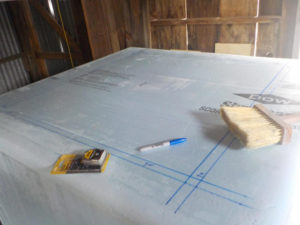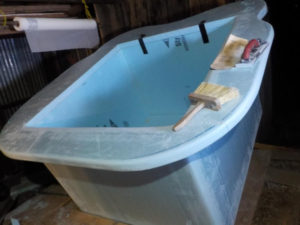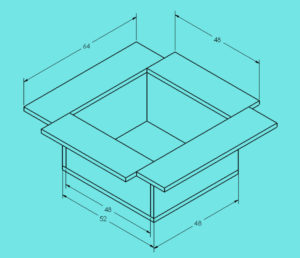Insulating Tanks
Foam Core Stress-Skin Shell Method for Insulated-Tanks
This method creates two very thin and strong shells that are comprised of a unique, ultra high-performance cementitious composite. This special high-strength coating is hand-applied with a trowel to both sides of a 2-inch thick extruded polystyrene insulation panels and embedded with layers of fiberglass grid reinforcing and finished with a brush-on glaze of similar material. The rigid blue foam panels are often called ‘Dow Board’ and they come in several thickness and varieties such as High-Load Dow Board that has a higher compressive strength than the regular 15 psi Dow Board.




The Insul-Tanks use 2 –inch thick regular Dow Board that comes in 4 feet by 8 feet by 2 inch sheets. The two, very thin, surface shells transform the foam into very rigid and damage resistant material because the high-strength composite and reinforcing create a stress-skin, or structural sandwich, effect. The composite wet mix plaster and the finish glaze are both made by combining special additives that are used for Ultra High Performance Concrete with pre-bagged polymer-modified cement.
This polymer-modified cement is readily available in building materials supply outlets that carry plaster supplies.
It is used as a base-coat for Exterior Insulation and Finish System (EIFS) as is the special fiberglass mesh that is used with it. Typically the base mix and glass make a sturdy shell for EIFS but adding the water-reducer/superplasticizer called Eucon SPJ and a refined pozzolan called Micron 3, greatly reduces the porosity and increases the density of the cement based shell resulting in a harder and more chemically resistant shell.


Adhesive Base Coat Mix
This usually comes in 50 lb bags and is used as plaster for embedding fiberglass mesh onto foam board for the exterior of buildings. It is called adhesive base-coat because it adheres the fiberglass reinforcing to the foam while making a hard protective shell. The finish system that goes over the adhesive base coat is usually a sprayed stucco texture of rubberized sand to make a nice smooth sandy finish. The adhesive base coat mix is a true polymer modified cement that consist of about 50 percent Portland Cement, 40 percent fine quartzite sand, and 10 percent dry (high-solids) acrylic usually an acrylic vinyl acetate co-polymer. Some common brand names are Dryvit, Primus, and UltraKote. The 50 lb sacks usually cost between $24 and $35 each. For this high strength version of this mix, it is necessary to only mix up a small 64 oz batch.
Crack-Free Fiber Glass Mesh
This mesh is specially engineered for a cementitious matrix because it is has a light rubberized coating to prevent alkali chemical attack on the fiberglass. This fiberglass mesh comes in 150 feet rolls that are 38 inches to 48 inches wide and that cost between $85 and $125 each. The fiberglass mesh is cut to match the layouts, the planned plaster area for a batch, so that two or three layers will be used. The layout is drawn onto the foam with a marker. The layout is between 6 and 10 square feet and will use the mix that is about ½ gallon. An additional line that is inset one inch from the edges of the layout is drawn to denote the overlap area to the adjoining pieces. On the overlap area, the fiberglass is not covered with extra composite material or a glaze, so the overlap can be seen and so the overlap area is not thicker than the rest of the shell.
Other Uses of this Foam Core Stress-Skin Shell Method
Besides the Insul-Tanks, this basic shell method can be used for many things where a durable, water-proof, and easy to shape and smooth surface is desired. The insulation really helps the material to serve other important purposes. There are some other uses for the Foam Core Stress-Skin Method, one being cantilevered counter-tops and shelves. For the counter-tops and shelves, the base material is easy to shape and sand, and the enhanced shell material is very durable and easy to repair. A 2 inch shelf can be fully supported from one side, provided it is bonding with the same material as a backing that is mounted to the wall or a self supporting unit that sits on the floor. This allows more open designs for counters such as counter tops that do not need cabinets below for supports. Open shelves can be placed below and above. Self-supporting prefabbed sections can be brought inside, or used as durable outdoor kitchen elements and assembled to make beautiful counter top and shelf assemblies transforming a bare room or patio into a functional and beautiful kitchen. The cantilevered shelves attach to the backing with a small radius instead of a sharp corner so it does not have dark, recessed, and dusty corners where spiders can build webs. That web-free corner combined with the more open design enabled by the stress-skin effect, makes the kitchen and bathroom designs easy to clean and brings in a new element of simplicity to design that was not available before.
The material is also well suited to create bathtubs, showers, and bathroom sink and shelf assemblies similar to the kitchen counter-tops and shelves. These surfaces should also be finished with a smooth glaze on the high-strength composite with chlorinated rubber paint (which makes for an easy to clean and durable surface).
Additionally,this is a great medium for making decorative doors and windows that have complex shapes. For making hatch designs that are more curvy than square doors, the medium allows you to sand precise shapes that will make a good weather seal. You can make conventional doors and window frame designs as well, but the insulation here makes this medium better. For the decorative doors and windows, the surface shell is very dense and hard but bonds to the chlorinated rubber paint better than other cement shells such as swimming pool concrete. This is because the sand aggregate in the enhanced polymer-modified mortar mix is much smaller and so will not flake away or weather away as quickly.
The harder mix allows the swimming pool paint to endure warmer temperatures because of the better bond. If the paint does show signs of weathering over the years, a fresh coat can be applied. If an epoxy paint is preferred for longevity, the composite can be sanded and prepped for an epoxy paint, that will endure heat better and is what is typically used for hot tubs, but the epoxy paint could fade in the sunlight whereas the chlorinated rubber endures ultra-violate better. The chlorinated rubber swimming pool paint may last longer on this particular composite design, even though epoxy based swimming pool paints will last longer on conventional concrete. Both are good options but on this shell, but it is easier to prepare the rubber painted surface for a new coating of epoxy swimming pool paint.
Installing Hardware (such as hinges and latches)
Hinges and latches bond differently to this medium than to wood. The bond is more durable because the anchor into the shell material on the surfaces rather than in the middle. The pins or bolts that support the hinges or other hardware go from one side of the stress-skin shell to the other and anchor to the plane of the shell, by using washers that are layered into the composite and fiberglass. In wood, a screw will rely on a friction bond on the inside. This bond can loosen over time as repeat strains are placed on the screw or as the wood shrinks and degrades over time. Plastering the hardware into both of the supporting shell makes it so that bending strains placed on the hardware will not weaken the connection. This is because the strains are more in-line with the direction of tensile and compression reinforcing on the hardened shell. The expected deflection caused by strong bending strains, such as hanging on a door or cabinet door, strains strong enough to damage the stress-skin shell surround the hardware, are not likely to dislodge the hardware because the pull-out resistance, the twisting resistance are all fully countered better than the breaking resistance around the hardware, meaning the stress-skin hull would break before the hardware pulled loose.